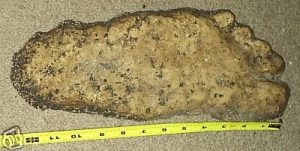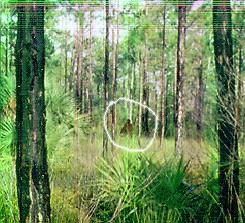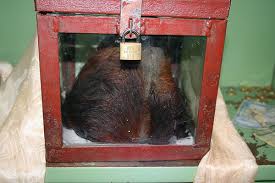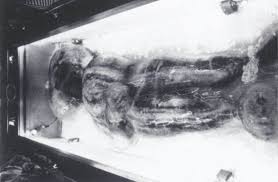“You’re gonna need a bigger boat.” – Jaws (1975)
Such was the stunned sentiment of police chief turned monster hunter, Martin Brody (portrayed by Roy Scheider), in the classic film. I’m sure many a person steered well clear of the ocean in the aftermath of the blockbuster that captured the imagination of a nation.
I find it interesting to ponder what sort of effect proving Bigfoot would have on those of us who enjoy wandering in the wild. Of course, I suppose a lot would depend on the temperament of the beast and his buddies once the word gets out that they’ve been discovered. But for now, that’s putting the cart before the horse. First we have to determine existence which leads to the following question:
“What are we gonna need, indeed?”

Alleged print from California
For the “we believe” camp, footprints and eyewitness accounts are enough, but what of such evidence? Hundreds of footprint casts have been collected over the years which show variation, anatomical accuracy and even injury in one notable case. Forensic examination has shown a fair percentage of these casts also contain what are known as dermal ridges, the equivalent of fingerprints. In addition, many have been found in remote locations where the odds of discovery are slim thus making a hoaxer a rather odd sort. The argument has been made that such a wide array of unique, widespread and detailed prints provides concrete (or would that be plaster) proof. At the very least, it would make for an elaborate hoax perpetrated by a substantial, coordinated and ambitious bunch of pranksters spanning at least seven decades.

Alleged photo of Florida’s Skunk Ape
And what sort of stock can be placed on photos and video? Computer technology has certainly muddied the water in recent years. With a computer, the right software and a little work you can pretty much put anything or anyone anywhere. Add access to the internet, a few clicks of a mouse and a photo/video sharing website and you’ve got the potential for an instant sensation, “going viral” I guess they call it these days. Yet there still remain some “old school” pieces of such evidence that continue to confound even after thorough modern analysis.
The reliability of eyewitness testimony is always up for debate and in the Bigfoot mystery the roster of those reporting sightings is a general cross section of society. Among this group, however, are seasoned outdoor enthusiasts, law enforcement personnel, forestry workers and fish and game officials. The significance of these individuals resides in the fact that they are either intimately familiar with the environments where they’ve seen the creature or they make a living in a field that requires tuning in to important aspects of chance encounters. It’s easy to dismiss many sightings as overactive imaginations, mistaken identity or just plain fabrication for a bit of excitement; but all of them?

Alleged Yeti scalp from Nepal
While eyewitness testimony can be an integral aspect of the criminal justice process, the scientific method will demand some eventual forensic proof. At the very least, this would likely mean some unique DNA obtained from a hair, blood, tissue or fecal sample. Even so, there will still be those in the scientific community who will need the ultimate and undeniable piece of evidence, a Bigfoot body.
With that comes a whole slew of ethical and logistical questions.
Is Bigfoot man or monkey?
Would the “hunter” wind up famous or infamous?
Would the potential financial windfall be worth the inevitable publicity nightmare?
A deer, a bear or a turkey is one thing, but could you pull the trigger on a biped and possible relative?
What would it take to knock down such a beast?
And, consider this, what if you only injure your target and he winds up more than a little upset?
What about a live capture with a trap or tranquilizer?
Then where does he go, stuffed in The Smithsonian, caged in the monkey house at the local zoo, off to grade school or possibly in a boxcar making the rounds with a circus or freakshow?
And getting around to the “bigger boat” quote, how do you propose to haul out a 7-8’ body weighing in the neighborhood of 600-800 pounds according to many eyewitnesses after taking him down in some remote patch of wilderness? Do you ask for help and risk somebody stealing your thunder or greedily guard your potential cash cow? And do you really want to be remembered as “the guy who shot Bigfoot” when it is no longer farcical and fictional tabloid fodder?
Probably not, if you take him down in Skamania County located in southwest Washington state. Since April 1, 1969 a law has been on the books stating that “any willful, wanton slaying of such creatures shall be deemed a felony” subject to substantial fine and/or imprisonment. In 1984 the ordinance was also amended to consider such a killing as homicide should the coroner deem the creature to be “humanoid.”
Regardless of the manner in which the discovery goes down, the quest for proof then ceases. The late Dr. Grover Krantz put it this way while attending a Bigfoot symposium back in the late 1990’s. “I will be very happy when it’s all over. Most of the other people at this meeting they’re gonna be very unhappy when it’s all over because one of their main reasons for existence is gone. Because once the scientists all take over, they’ll shove all these amateurs aside.”

Alleged “Bigfoot” body known as “The Minnesota Iceman.”
While I understand the need for a body, I kind of hold out hope that one never shows up as it would sure ruin all of the fun. Thus, if Bigfoot would ever happen to step out of legend and into my crosshairs I can state with certainty that I’d let him walk. I don’t need the grief or the guilt. Besides, I’d have my answer.
Yet again, Dr. Krantz was spot on in summing up this dilemma stating, “If the time comes when I have the choice of shooting or not, it will be the most difficult decision I have ever been faced with. And, however I decide to act, I will regret it for the rest of my life.”
Well said.
Talk to you tomorrow. Troy